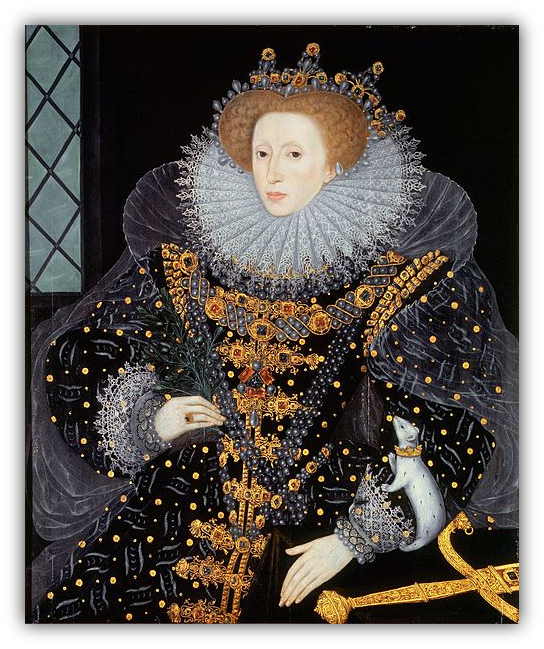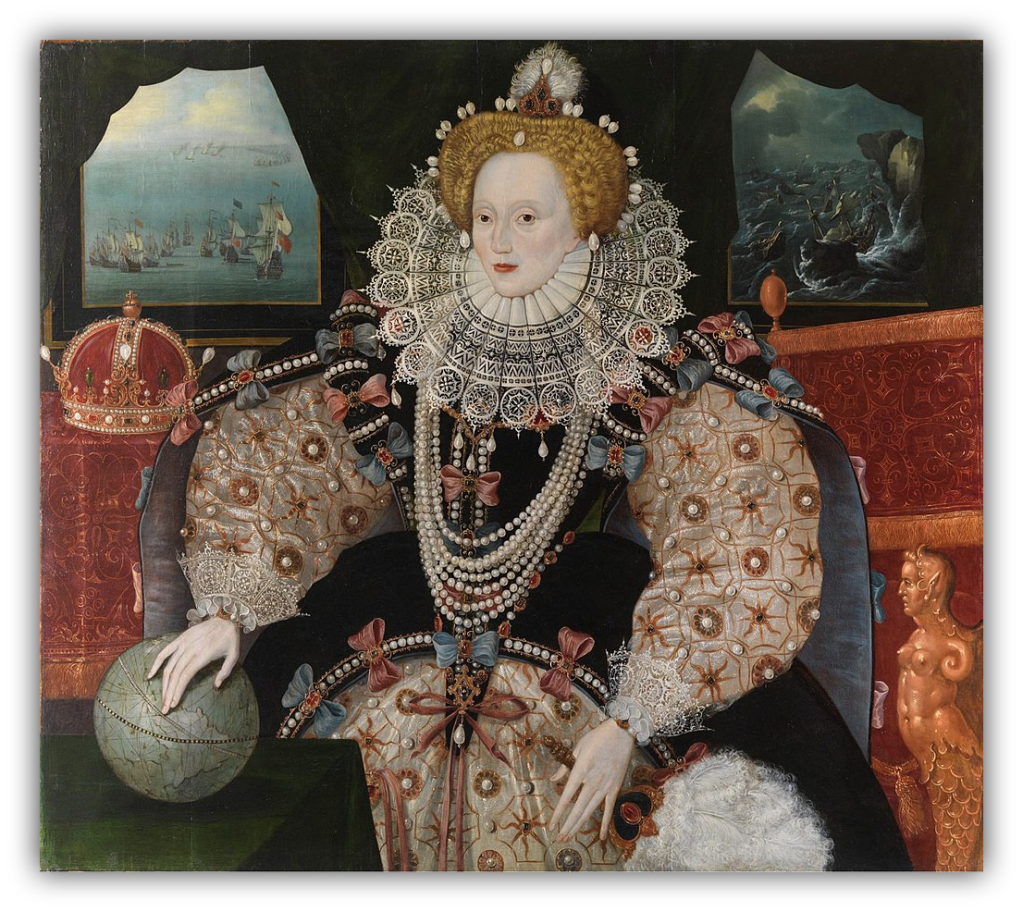Elizabeth I is still venerated today as one of the great rulers of English history, and this is thanks not only to her achievements as a monarch but also to the memorable invention of herself as a legend in her own lifetime.
Aware of the power of appearances, Elizabeth I of England, carefully controlled her image throughout her reign and through costume, jewellery, art and even her hair, she presented herself as the great Virgin Queen.
For those in her kingdom who could not witness the marvelous spectacle of the queen’s great dresses, jewels, and wigs, there were official royal portraits which were packed with symbolic meaning.
As few would ever see their queen in person, portraits were an especially powerful way of communicating the message of Elizabeth’s right to rule and her success at it.

Portraits were regularly commissioned using celebrated artists, although they often show the idealised, ‘Mask of Youth’ of the queen, even if some do show a slight ageing of their subject as she went through her 44-year reign.
The miniaturist specialist Nicholas Hilliard produced officially-approved idealised portraits, albeit exquisitely rendered in gold and other precious materials like the famous Armada Jewel.
The queen’s larger portraits copied this idealised approach, but they have the additional interest of being packed full of meaning and symbolic imagery.
So carefully orchestrated was this build-up of the flattering royal portrait album that from 1563 CE, Elizabeth even banned the production of unofficial portraits of the royal person.
In this video, we will examine five of the most famous of Elizabeth’s portraits painted during her lifetime with all the symbolism and beauty she used to hold and grown her power.

First is The Pelican Portrait
The Pelican Portrait, so-called because of a pelican brooch the queen wears, was painted around 1574 CE by Nicholas Hilliard.
The queen is wearing a red and cream dress studded with pearls and square-cut jewels. The pelican brooch hangs at the centre of Elizabeth’s chest with its wings spread wide.
The bird was a symbol of redemption and charity. A mother pelican was said, in times of strife, to pierce her own chest to feed her young from her own blood.
Above the queen, on the left, is the Tudor Rose and on the right the fleur-de-lis, symbol of England’s ongoing claim to the French throne.
Above both of these symbols is an arched imperial crown. The Pelican Portrait now resides in the Walker Art Gallery, Liverpool, England.

Second is The Sieve Portrait.
The Sieve Portrait, so-called because the queen holds a large sieve in her left hand, was painted between 1579 and 1583 CE by the Flemish artist Quentin Metsys the Younger.
There are, like many of the queen’s portraits, other versions of this painting, and the sieve, symbol of chastity, identifies Elizabeth in the role of the Roman Vestal Virgin, Tuccia from Roman mythology.
Tuccia was a Vestal Virgin who demonstrated her chastity by carrying water from the Tiber River to her temple only using a sieve.
In the portrait, Elizabeth wears an unusually plain black dress with white lace trim (both colours being symbolic of purity and constancy) and a necklace of black pearls with an impressive brooch.
The left of the painting shows a column decorated with scenes from the Aeneas and Dido story of Roman mythology. Aeneas abandoned the Queen of Carthage and so chose power over personal happiness.
The story is, then, a fitting one for a portrait of the Virgin Queen who shunned marriage and became Mistress of her kingdom.
Behind Elizabeth on the right of the painting is a globe on which sail English ships, symbolic of the queen’s imperial power.
The men in the background are courtiers, one of whom is the queen’s favourite of the period, Sir Christopher Hatton, shown in the centre.
The painting now resides in the Pinacoteca Nazionale, Sienna, Italy.

Third is The Ermine Portrait.
The Ermine Portrait, so-called because of the presence of that animal on the queen’s left lower arm, was painted around 1585 CE. It has been attributed by some scholars to William Segar.
Resplendent in a sumptuous black dress with gold trimmings and jewels, the Queen is wearing a triple string of black pearls.
The queen has a gold sword, perhaps the sword of state and representing justice, on a small table within easy reach of her left hand.
The ermine climbing onto the queen’s arm was a symbol of purity and royalty, and here the animal even wears a gold crown around its neck.
Elizabeth holds an olive branch, a traditional symbol of peace, in her right hand. The Ermine Portrait now resides at Hatfield House, Hertfordshire, England.

Number 4 is The Armada Portrait.
The Armada Portrait, so-called because the windows behind the queen look out to the sea battle against the Spanish Armada, was painted around 1588 CE, shortly after the Armada was defeated. It is attributed to George Gower, although various versions exist.
In this portrait, the queen wears a black and silver-cream dress with billowing sleeves studded with pearls and a black cloak.
Elizabeth is also wearing a necklace with eight strings of pearls, there are pearls hanging from her torso and yet more pearls arranged in her hair.
Looking youthful for her 57 years, the queen holds the handle of a fan in her left hand while her right is placed over a globe to symbolise England’s burgeoning ambitions for empire-building.
Appropriately enough, the queen has her hand over North America, the location of England’s first colony Virginia.
On the left is the Tudor imperial crown and at the far right in the foreground is a golden statue of a mermaid.
Behind the queen, the window on the left shows the two naval fleets about to engage while the window on the right shows the Spanish being battered by storms and wrecked against a rocky shore.
The most famous version of the Armada Portrait now resides in the Royal Museums, Greenwich England.

For number five of Elizabeth the First’s portraits, we have The Rainbow Portrait.
The Rainbow Portrait, so-called because the queen grasps a rainbow in her right hand, was painted towards the end of Elizabeth’s reign, between 1600 and 1602 CE. It has been attributed to various artists.
Here, the queen wears a cream dress embroidered with wildflowers and dripping in pearls.
On the queen’s left lower arm is a snake, symbol of wisdom, with a heart-shaped ruby pendant hanging from its mouth.
The bright orange lining of her cloak is curiously covered in eyes and ears, symbolic that the queen was ever-vigilant in looking out for the best interest of her subjects.
Above the rainbow which is a symbol of peace, there is an inscription which reads ‘No rainbow without the sun’ with the message being the queen’s wise rule is as important as the sun to the prosperity of her kingdom.
The Rainbow Portrait also now resides at Hatfield House in Hertfordshire.
The Rainbow Portrait also now resides at Hatfield House in Hertfordshire.
Source:
Cartwright, Mark. "Elizabeth I & the Power of Image." World History Encyclopedia. World History Encyclopedia, 29 May 2020. Web. 14 Jun 2021.
